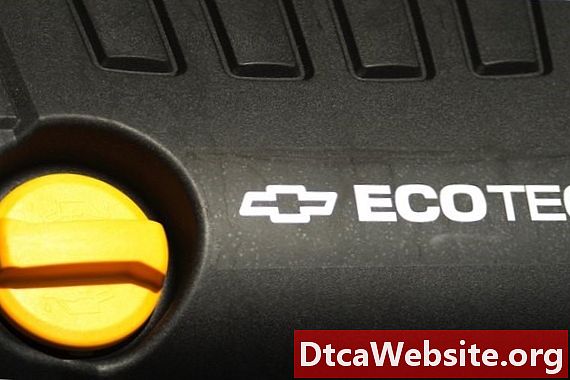
Contenu

Auto body work can be very gratifying, and yet it can be very challenging. It is almost as if you are creating a work of art in the form of a sculpture when you reshape and mold car panels. Whether you are pounding out a large dent, working with Bondo filler or glazing over small scratches, you need to acquire a special touch to get the body just right and ready for paint. Get a general overview of what you can do with body work.
Step 1
Get under the damaged area of a large dent using a hammer and dolly system. Place the dolly on the outside of the dent and pounding the metal from within to bend the metal back to its original shape. If you cant access the rear of the panel you may end up using metal pullers which can be set up to pull the dent forward. In more serious cases, the bent panels may have to be pulled out with special machinery. The object here is to pull the metal back to its original position, or replace the panel with a new one if necessary.
Step 2
Fill over a panel that you straightened out or fill in a smaller dent with a Bondo body filler. You can even use a finishing putty that is meant to apply in thinner layers, whereas Bondo can be put on thicker. When doing body work, you want to use as little filler as possible. Youre best off when your metal is pretty much straight rather than built up out with fillers, which may ultimately crack and fall out of place. Spread on evenly, let it dry hard and then sand down using 60 to 120 grit paper and finish off with finer grits to feather edge into surrounding surfaces.
Step 3
Cut out any rusted sections with a cutting tool if you are dealing with rust removal. Then weld in new metal as a patch, being sure that you have cut away all the rust first. In this case you will have to fabricate a piece of sheet metal, typically 22 gage, to fit the opening. You will then need to grind down the high weld spots and use a filler to smooth over the new metal and feather the edge into the existing metal.
Step 4
Sand down scratches, old paint, clear coat or smaller flaws using 120 to 220 grit paper to get down below the clear coat and paint. Then you can use a glazing and spot compound which is meant to fill in minor dings or scratches. Apply in thin layers. Wait for each layer to dry, sand it flat with a fine grit paper and apply another layer until the area is level and smooth. You can use the same compound to fill in pin holes and to feather edge any slightly rough edges left behind from body fillers.
Step 5
Sand with 400 grit paper or use a scuff pads when no real body work is needed, but you just want to prepare for primer and new paint. Dust off all sanding debris or blow clean with an air hose. Always use a wax and oil remover before spraying on any primers or sealers.
Step 6
Block sand using a different color primer as a guide coat to get a very smooth surface after body work of any kind has taken place. Block sanding is time-consuming and tedious, but must be done. Your flexible sanding block should be at least 12 inches long, and when sanding over primer you should use anywhere from 300 to 400 grit wrapped around your block. Use long strokes in different directions with equal and firm pressure. A guide coat of a different color primer should be applied over the original primer. As you block sand and begin to remove the primer, you will see any low spots that remain untouched of the original primer. These low spots can be filled in with glaze or filler or sometimes further block sanding will level out the area. The old saying for a perfectly smooth body is, "Once you think you are done block sanding, do it again, and then one more time." The perfect paint jobs and smooth bodies took a lot of hard work to obtain which included a lot of "block sanding."
Step 7
Spray on primers and primer sealers on a regular basis during body work. You should never spray primer, however, until youve sanded the old painted surface, then you should use an oil or grease remover, laquer thinner or other oil-free solvent before any primer is applied. Final sanding of primer before sealer should be done using a 400 to 600 grit paper. A final wipe with grease or oil remover solvent should be used one more time here before primer sealer is applied. Primer sealer is used as a final spray just before paint is sprayed on the vehicle, which serves to seal in the primer and give you a very smooth finish.
Survey the body damage first Before jumping into any body work, always be sure to survey the damage, plan your moves ahead of time and have all the supplies you will need in advance. Patience is a must and what you think will take you one hour, may take you two or three.
Tips
- When doing body work, check for smoothness with a cloth "glove" on your hand, which will keep oils off the surface and also allow you to feel more imperfections than you would with a bare hand.
- Patience is critical to doing good body work. When you try to rush through it, your paint job will show your flaws and tell on you.
- Minimize scratching by using the right sand paper for the job. Too coarse a grit will sometimes cause more damage than good. If you must start out with a heavy grit, do so, but then work your way down to a finer grit to remove any scratches caused by the heavier grit.
- Check your work in different lighting, looking for waves or flaws. Use 500-watt halogen, 40-watt standard bulbs, fluorescent lighting and natural outdoor lighting. What may appear to be perfect in one light will appear to look bad in another light. When your work looks good in any light, you have done your job well.
- Be sure that all oils, grease, wax or other contaminants have been removed before applying primers or paint.
Warning
- Always wear a respirator when sanding, spraying paint or primer or working with strong solvents, such as lacquer thinner.
Items you will need
- Sandpaper (from 60 to 600 grit)
- Hammer
- Dollys or dent-pulling tools
- High-build primers
- Bondo body filler
- Finishing putty
- Glazing compound
- Metal cutting tools
- Welding equipment
- Respirators
- Wax and grease remover solvent


